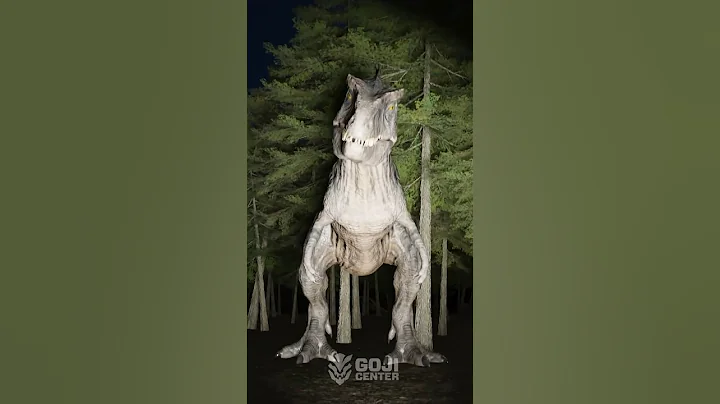Paleontologists around the world have unearthed many dinosaur fossils. An extremely diverse group of animals, dinosaurs came in all shapes and sizes, ranging from as small as a chicken to enormously huge. Likewise, their overall ferocity varies greatly. The 10 Deadliest Dinosaurs of All Time. Here's a brief overview of each dinosaur's size, behavior, and general characteristics. Readers are welcome to join the discussion. Are there any familiar dinosaurs in the article?
Selection criteria
In order to rank the world's deadliest dinosaur species, there are some basic criteria. First, it's important: Herbivores are largely excluded from this list because of their tendency to avoid conflict whenever possible. Therefore, the following mainly talks about carnivorous dinosaurs.

10. Velociraptor
Average size : 2 to 5 meters long and 1.8 meters high
Average weight: 15 kilograms
Time frame: Late Cretaceous (70 million years ago)
The deadly Velociraptor was a The dromaeosaurid theropod dinosaur appeared in the late Cretaceous period 70 million years ago. Velociraptor, which mainly lives in modern China and Mongolia, is a relatively small dinosaur. Some of the species' most distinctive features include large sickle-shaped claws on each hind foot, as well as an elongated skull, upturned snout, and short body. In terms of size and weight, it is comparable to the big turkey .
Most researchers believe that Velociraptors were a nocturnal species. Velociraptors are said to have hunted in packs, a phenomenon indicated by many fossil remains. Velociraptors are the "scavengers" of the wild. Common prey may include small lizards, amphibians , insects, rodents (both large and small), small dinosaurs, and other velociraptors.
How deadly were Velociraptors?
Although Velociraptor was a very small dinosaur for its time, it was a very dangerous (and deadly) animal because of the huge sickle-shaped claws adorning its second toe. Coupled with their hand-like appendages, which also possess three curved claws, these sharp claws are capable of cutting (and grabbing) prey with ease. Velociraptor is classified by many researchers as a ruthless killer due to the presence of 26 to 30 sharp teeth (the upper and lower jaws come together), which can quickly devour its prey (after tearing it apart). The animal is widely spaced and jagged, capable of unleashing a bite force of 1,000 PSI on its victim. This bite force exceeds that of a modern grizzly bear, maintaining a bite force of nearly 975 PSI.

9. Maposaurus
Average size: 14.5 meters
Average weight: Up to 12 tons
Time frame: Late Cretaceous (93 million years ago)
Maposaurus (meaning "earth lizard") is a A large carnivorous dinosaur that lived in the late Cretaceous period. Mapusaurus lives mainly in modern Argentina and was first discovered in 1997 by Rodolfo Correa and Phil Currie. It was an incredibly large dinosaur, reaching nearly 10 tons when mature and nearly 15 meters in length. Having a similar body structure to Tyrannosaurus rex, this animal is known for its length and muscularity, with a long and narrow skull. They are also extremely fast.
From its natural habitat, the mapron is a terrestrial animal that inhabits the woodlands, grasslands, and semi-arid areas of South America. The animal hunts in small groups and may hunt larger herbivores, with Argentinosaurus being its favorite. Maposaurs would eat large numbers of smaller lizards, reptiles, and mammals.
How deadly is mapron?
Maposaurus was an extremely dangerous dinosaur species known for its massive size and strength. With a bite force of approximately 7000 PSI (far exceeding the American alligator 2980 PSI), this animal can injure (and kill) almost any opponent in the wild. Due to their massive size, maposaurs were also endowed with magical powers that allowed them to easily defeat smaller (and sometimes larger) dinosaurs.This, coupled with their speed, can quickly overwhelm potential aggressors before they can set up a defense. They were one of the deadliest (and most terrifying) dinosaur species to ever exist.

8. Allosaurus
Average size: 8-10 meters
Average weight: 1.5-3 tons
Time range: Late Jurassic (155 to 145 million years ago)
The ferocious Allosaurus was A carnivorous theropod that lived in the late Jurassic. Allosaurus is classified by researchers as a bipedal predator that inhabited parts of North America and western Europe due to the large number of fossil remains found in these areas (as of 2022). Described as an apex predator at the time, Allosaurus was an incredibly large dinosaur. This animal is similar to Tyrannosaurus rex in that it maintains a large, narrow head, long (and muscular) tail, and two powerful hind limbs.
In its natural habitat, Allosaurus was a land-dwelling dinosaur that actively hunted with others of its kind. The species' primary diet consisted of large herbivorous dinosaurs, including ornithopods, stegosaurs, and various sauropods. Recent excavations suggest that Allosaurus may have also hunted other predators in the wild, including its own species. member (indicating cannibalistic behavior).
How deadly is Allosaurus?
The Allosaurus was an extremely deadly animal known for its massive body and strength. Classified by researchers as an extremely ferocious and aggressive predator in the wild, Allosaurus had muscular arms and legs and approximately 32 serrated teeth that could be used for both offensive and defensive purposes. Likewise, their skulls are so strong that they can use their mouths like an "axe" to attack their opponents. By swinging its head, the Allosaurus can slash its victim, causing massive damage and blood loss. Add to that their bite force of about 1500 PSI (on par with modern wolves in terms of strength).

7. Sauroporax
Average size: 10 to 15 meters
Average weight: 2-5 tons
Time frame: Late Jurassic (151 million years ago)
The deadly Saurusaurus is A giant allosaurid dinosaur that existed in the late Jurassic period. Sauroporax is classified as a bipedal predator (similar to Allosaurus) and was first discovered in 1931 by John Willis Stovall. This dinosaur lived mainly in North America and was known for its large size. They have elongated skulls, large hind legs, and muscular tails, which help them maintain a sense of balance when moving (or jumping).
Judging from their natural habitats in the wild, most Sauroporax dinosaurs lived primarily in woodlands rich in prey. Although little is currently known about their hunting habits, most researchers agree that Sauroporax likely hunted larger sauropods such as amphibians, Apatosaurus, and the large Diplodocus .
How deadly is Lizardosaurus ?
Sauroporax was an extremely dangerous dinosaur during the Jurassic period and one of the deadliest species that ever existed on Earth. Similar to the basic characteristics of Allosaurus, the animal had muscular arms and legs, as well as powerful claws that could be used to slash and tear apart its victims. Saurosaurus can easily overwhelm its opponents through sheer strength and size. Few dinosaurs can match its overall strength, size and ferocity.

6. Giganotosaurus
Average size: 13 meters
Average weight: 8-11 tons
Time range: Late Cretaceous (97 million years ago)
Giganotosaurus is a beast that existed in the late Cretaceous period Foot dinosaur. First discovered in 1993 near the Candeleros Formation of Patagonia, it was one of the largest terrestrial carnivores that ever existed on Earth and lived mainly in South America. Giganotosaurus had a long and narrow skull, powerful hind legs, short arms and a powerful tail.
Giganotosaurus spent most of its time around Argentina, where it lived primarily in plains and woodlands, where it could aggressively hunt many prey. Most scholars believe that this animal mainly fed on large herbivorous dinosaurs. These include the giant Argentinosaurus, Andesaurus, and Limarosaurus. As an apex predator, Giganotosaurus supposedly posed no real threat in the wild, other than its own kind.
How deadly was Giganotosaurus?
Giganotosaurus was an extremely deadly dinosaur from the late Cretaceous period, known for its massive size and strength. Although the fossil record is limited, scientists have noticed that this particular species had muscular arms and legs and had three sharp claws capable of chopping (or tearing apart) its victims with ease. Likewise, their teeth were large and serrated, with some of them exceeding 20 centimeters in length. They are capable of killing animals in seconds, and their bite force has exceeded 8,000 PSI of pressure.
Further enhancing these basic offensive (and defensive) abilities is the dragon's incredible speed, as the animal is capable of reaching top speeds of 50 kilometers per hour. Combined with their sheer size and strength, it's easy to see why this species is one of the most dangerous predators to ever live on Earth.

5. Majungasaurus
Average size: 7 meters
Average weight: 1.2 tons
Time frame: Late Cretaceous (70 to 66 million years ago)
The deadly Majungasaurus (meaning "lizard of Madagascar") ) is an abelisaurid theropod dinosaur that lived in the late Cretaceous period. Majungasaurus was a bipedal predator endemic to modern Madagascar and one of the last known extinct non-avian dinosaurs. Maintaining a similar (but smaller) frame to Tyrannosaurus rex, Majungasaurus is known for its short stature and incredible length. The top of its snout is decorated with a distinct bone and single horn.
From its natural habitat, Majungasaurus lived in coastal plain areas. Especially sandy areas near various rivers. However, some scholars hypothesize that the animal might also have lived in the region's numerous tropical forests and woodlands, where prey would have been more abundant. Typical food sources for Majungasaurus include various sauropods from the area (such as Stegosaurus). Recent evidence also suggests that the species may have also shown cannibalistic tendencies, being one of the few dinosaurs known to exhibit such behavior.
How deadly is Majungasaurus?
Majungasaurus is an extremely dangerous species, known for its huge body and strength. With its muscular body structure, this animal can easily subdue large prey. Likewise, the animal's bite force was over 6,700 PSI, exceeding the 3,700 PSI bite force of a modern saltwater crocodile. Fossil records indicate that the animal would often bite its victims, gnawing at their bodies until they could kill. Combined with its curved teeth (which aided in cutting and piercing), Majungasaurus was a very deadly animal.

4. Carcharodontosaurus
Average size: 14 meters
Average weight: 6-11 tons
Time range: Late Cretaceous (100-94 million years ago)
Carcharodontosaurus (also known as Macrodontosaurus ) is a large carnosaurid theropod dinosaur that lived in the late Cretaceous period. Carcharodontosaurus is endemic to modern North Africa and is one of the largest carnivores ever seen on Earth. On average, the current fossil record shows that the average length of this animal was 14 meters. In terms of weight, Carcharodontosaurus weighed an astonishing 6-11 tons when mature. They are easily identifiable by their massive skulls, large jaws, muscular bodies and huge tails, similar to Tyrannosaurus rex.
In North Africa, Carcharodontosaurus lived near rivers and lakes, where there were abundant water sources and food. The animal preyed on many herbivores, including ornithischians, spinosaurs, and sauropods. They are the apex predator in their ecosystem.
How deadly was Carcharodontosaurus?
Carcharodontosaurus was an incredibly large dinosaur, capable of subduing almost any kind of prey (or enemy). This is due in part to the animal's sheer size and weight, which allows it to quickly overwhelm its victims with sheer force alone. Scholars estimate that Carcharodontosaurus was able to lift animals weighing nearly 400 kilograms using only its jaw and neck muscles. The animal's bite force is estimated to be capable of exerting over 5,300 PSI of pressure; therefore, it can bite through almost any body structure with ease.

3. Spinosaurus
Average size: 11-15 meters
Average weight: 4-10 tons
Time range: Late Cretaceous (93.5 million years ago)
The large and deadly Spinosaurus (meaning "spined one") "Lizard") is a spinosaurid dinosaur that lived in the late Cretaceous period. The species is endemic to North Africa and was first discovered in 1912 by German paleontologist Ernst Stromer. Classified as the largest terrestrial carnivore in history, Spinosaurus is identified by its long, narrow skull that resembles modern crocodiles. Likewise, they are known for their long, muscular forelimbs, unique neural spine, and muscular body.
From their natural habitat, Spinosaurus is classified as a terrestrial and aquatic animal, and their movements on land and in water equal in time (again, similar to modern crocodiles). This animal preys on a large number of fish and aquatic life . However, fossil remains indicate that Spinosaurus also preyed on terrestrial prey, including Iguanodon, Pterosaurus, and other large animals. There is also evidence that Spinosaurus was a scavenger, as it was likely an opportunistic predator that ate whenever it had the chance. In terms of predation, this animal is often classified as an apex predator because it encounters no known enemies in the wild.
How deadly was Spinosaurus?
The largest terrestrial carnivore that ever lived, Spinosaurus was an extremely deadly animal known for its immense strength, speed, and power (on land and in water). Therefore, this animal is ideal for hunting small and large prey, as their size and strength (alone) are enough to easily overpower most opponents. Spinosaurus had about 64 teeth in its narrow snout and was also capable of delivering flesh-piercing bites due to the tapered and needle-like design of its tooth structure. This is greatly enhanced by Spinosaurus' bite force, often exceeding 4,200 PSI per bite. When combined with their flexible tails (which can be used for flapping) and powerful claws, they can deliver a fatal blow to almost any dinosaur they encounter. They were among the deadliest dinosaurs of all time.

2. Utahraptor
Average size: 7 meters
Average weight: 680 kilograms
Time frame: Early Cretaceous (120 million years ago)
The infamous Utahraptor was a species that lived in the early Cretaceous period Medium to large dromaeosaurid dinosaur. Utahraptor is endemic to North America and was first discovered in 1975 by Jim Jensen around the Dalton Wells Quarry in eastern Utah (hence the name). Classified as a bipedal predator, this animal typically reaches a height of 1.5 meters and reaches a staggering length of 5 to 7 meters when mature. In terms of weight, Utahraptor weighed 680 to 900 kilograms (in terms of weight, it is comparable to the modern polar bear ). This dinosaur had a long and narrow skull, a slender and muscular tail, and powerful hind limbs, similar to the curved claws of a velociraptor. Recent evidence also suggests that Utahraptor may have had feathers throughout its body similar to those of modern birds.
In its natural habitat, Utahraptor lived in semi-arid environments near floodplains , riverine forests, and open woodlands. It hunts in packs and eats any food (dead or alive) it encounters. A ferocious hunter, this animal also took an active part in large sauropods as well as the ankylosaurs that roamed North America. Due to its size, strength and extraordinary intelligence, Utahraptor has no known predators and is generally considered an apex predator by academics.
How deadly was Utahraptor?
Due to its extraordinary speed and strength, Utahraptor was an extremely deadly and dangerous dinosaur during the early Cretaceous period. One of its most powerful characteristics is the incredible intelligence of this animal. Utah Raptors operate in large groups and have a strategic mindset that allows them to herd aggressively and set traps for their victims. Once caught, the animal is capable of launching a series of devastating attacks through bites and rapid slashes. Similar to Velociraptor, each Utahraptor had a large, sickle-shaped claw that was more than 20 centimeters long. These claws are extremely sharp and can inflict deep (fatal) wounds. Likewise, the animal also possesses a large number of sharp (and serrated) teeth that can easily tear through flesh thanks to their bite force of approximately 600 to 950 PSI. Combining their incredible speed, agility and aggressiveness, Utahraptors were among the deadliest dinosaurs to inhabit our planet.

1. Tyrannosaurus rex
Average size: 4 to 6 meters (height); 12 meters (length)
Average weight: 5 to 9 tons (heaviest 14.85 tons)
Time range: Late Cretaceous (66 million years ago) )
Topping the list of the world’s deadliest dinosaurs is the infamous Tyrannosaurus Rex. Tyrannosaurus rex, often called the "King of Dinosaurs," was a large theropod dinosaur that lived in the late Cretaceous period. Endemic to western North America, this animal is classified as a bipedal carnivore and was one of the last non-avian dinosaurs to survive before the Cretaceous-Paleogene extinction event. Tyrannosaurus rex is famous for its huge size and strength, and is known to have reached an incredible height of 3 meters and a total length of approximately 12 meters. In terms of weight, the animal typically weighs between 5 and 8 tons at maturity. It has a huge skull, long teeth, muscular hind limbs, and short forelimbs.
From their natural habitat, Tyrannosaurus rex inhabited forested areas near rivers, as well as more open areas where prey was more abundant. The fossil record also points to other natural habitats, including coastal marshes and subtropical areas with high humidity. Tyrannosaurus rex was an apex predator with a wide selection of prey. Common food sources include Triceratops , Edmontosaurus, Hadrosaurus , and various large herbivores. Many scholars also believe that T. rex likely stole food from other predators when the time came.
How deadly was the Tyrannosaurus rex?
Tyrannosaurus Rex was an extremely dangerous and deadly dinosaur due to its extraordinary strength, size, and power. Like many dinosaurs, T. rex's size played a large role in its overall hunting (and killing) ability, as the animal was able to overwhelm most victims through sheer strength alone. Once subdued, the T. rex could deliver a powerful bite to its victim, causing massive blood loss and irreparable damage to their anatomy. In fact, Tyrannosaurus rex had the most powerful bite force of any land animal in history. The bite force is generally 90,000 Newtons to 120,000 Newtons, allowing them to easily tear skin and bones. Tyrannosaurus rex is the deadliest and most dangerous dinosaur that ever lived.





















